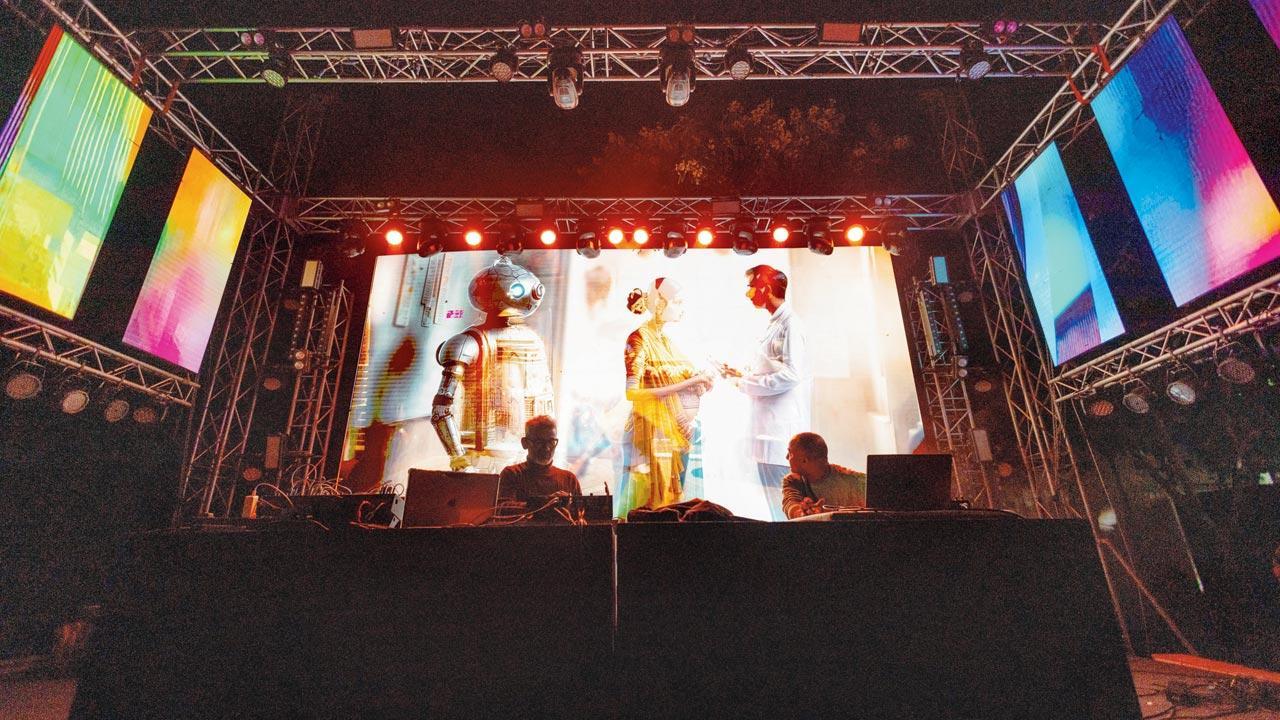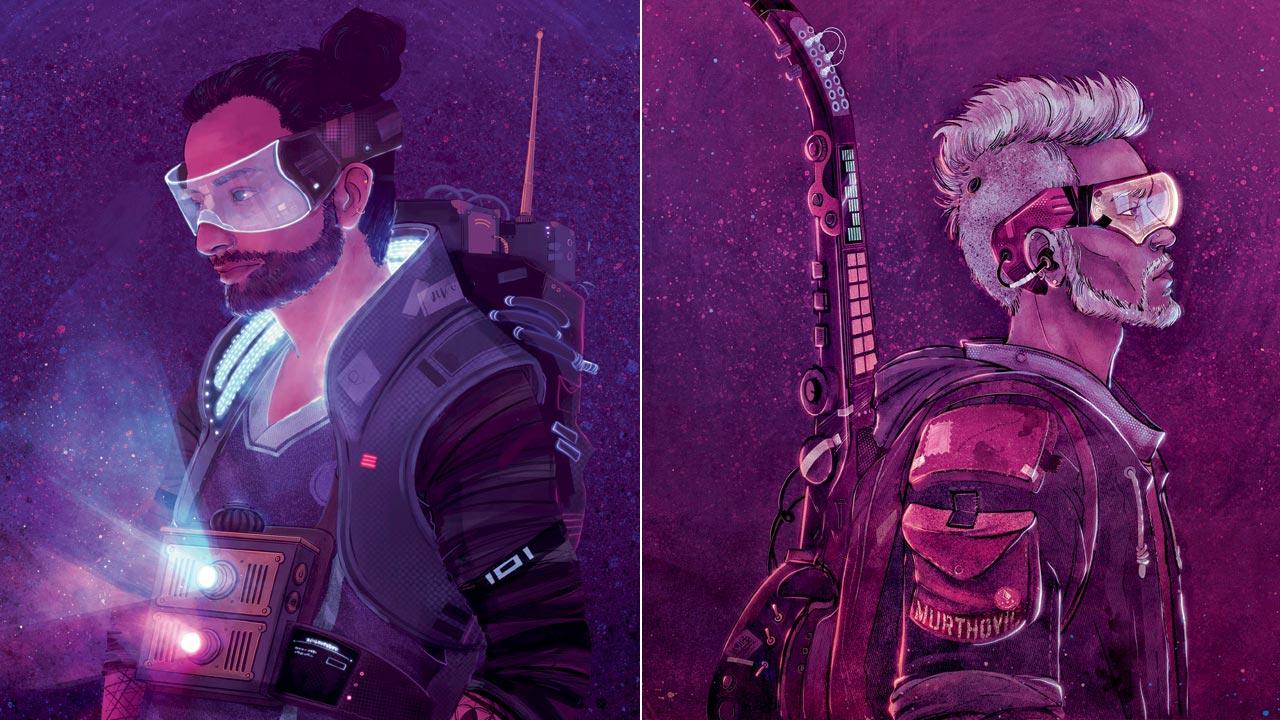An electronic visual duo is showing a glimpse of India from the future, keeping the focus on culture and heritage, as they play with archival sounds sourced through AI

The genre-agnostic duo show a story of Meenakshi, a cultural cyborg with Murthovic and Thiruda with an aim to protect and preserve the Indian culture and heritage in future. Pic/Abhishek Shukla
What would India in 2079 sound and look like? Audio-visual artistes Murthovic aka MSR Murthy and Avinash Kumar, who go by the moniker Thiruda, show us a glimpse of this futuristic world through their music project, Elsewhere in India.
ADVERTISEMENT
What can be loosely described as Carnatic music meets electronic music meets AI-generated art, made its debut in the city last week. Their live shows are a transmedia performance, featuring digital human avatars of Murthy and Kumar, in their own show.
“We have been working on a video game called Antara for the past seven years,” says Kumar. Antara is said to be India’s first cultural adventure video game, produced by Antariksha Studios, an Indian transmedia collective focused on crafting Indian cultural experiences for global audiences through video games, performances and new media. It was founded in 2020 by Murthy who focused on music, Kumar, the brain behind visuals and Jayalakshmi Eshwar, whose expertise is dance. “Working together,” adds Goa-based Kumar, “led us to create Elsewhere in India where we could combine live performance and online games.”
 Artistes Murthovic aka MSR Murthy and Avinash Kumar, who go by the moniker Thiruda; the faces behind Elsewhere in India feature their own digital avatars
Artistes Murthovic aka MSR Murthy and Avinash Kumar, who go by the moniker Thiruda; the faces behind Elsewhere in India feature their own digital avatars
The duo started discussing this project towards the end of 2019, but call it a “pandemic project.” Since its inception, they have managed to bag the grant recipient of the British Council’s India/UK Together Season of Culture 2022-23, a cultural exchange programme celebrating India’s 75th Anniversary and friendship between the UK and India. With successful tours in Australia and UK, it was only last year at electronic music festival Magnetic Fields in Rajasthan, that they made their India debut.
“For the kind of stuff we do,” says Hyderabad-based Murthy, “we need a good partner who has good tech required for an audio-visual show. That is challenging and also it’s expensive to do such kinds of shows,” he adds. Kumar also feels it’s the age-old paradox where “Indians are more interested in what happens aboard and foreigners are more interested in what happens in India. It is an unfortunate socio-cultural reality that might make us more appealing to festivals abroad at times.”
Elsewhere in India through its visuals paired with sonic sounds shows a story set in the future—in 2079—by tracking three characters. The protagonist, Meenakshi, is a cultural cyborg and her crew consists of artistes such as Murthovic and Thiruda, who have formed a band. The main aim of Meenakshi is to protect and preserve the Indian culture in a dystopic future where culture and heritage is rare and fragmented. It is the job of the trio to remix whatever fragments of heritage they can find in the future.
Their project has different parts, they tell mid-day during a video interview. “One Part of the project is the live performance that is supported by the visuals made in the game version. The music is supported by Murthy, and we are doing it in such a way that music is part of the video game and there is an interaction between the two.” They customise their set and style based on the location and the type of venue. For instance, their Mumbai show was focused on people dancing, whereas their show at Adelaide Fringe Festival in Australia was in a 180-year-gallery, and was followed by an hour-long Q&A.
Sonically, their sound includes samples from the British and Indian museums, remixed into songs, that reimagine the use of archival sound. They also incorporate local and folk collaborations where Murthovic recorded with 40+ artistes across South India and Kolkata. “We have modernised a lot of sounds from films approved by the British Film Institute for us,” says Murthy. “We have used mono recordings from yesteryears and old recordings from documentaries such as dialogues,” explains the 47-year-old electronic music artiste. Hailing from a “VJ-ing” culture, Kumar believes that remixing is an integral part of their culture; they wanted to bring that forth with the help of sound archives. They have worked closely with a museum in Tamil Nadu called Dakshinachitra and in the UK with the British Film Institute (BFI), and are in conversations with museums such as Victoria & Albert (V&A), Manchester Museum and Horniman Museum. “Archives, for us, also include creating new archives through recording sessions with a folk or classical musician or a vanishing art form. These are part of the community archives,” believes Kumar. They have worked with unique instruments, including percussion like parai, which is played at funerals and rare artefacts like the panchamukha vadyam, a five-faced metal drum.
“The idea,” says Kumar, “is to do a bunch of experiments and use AI to show how it can be creatively used for archives, because all cultural institutions are scared of AI. They feel it is replacing culture. But we want to show that it can be beneficial if thought through in a holistic manner.” For now, they say they are having fun with it—one of their tools helps in splitting the music in separate layers such as guitars, vocals, violin, etc and chopping sentences and dialogues into stems from different archival recordings with a vintage texture of audio. But as Murthy says, “It will take around two to three years to develop this project as AI is ever-evolving at a rapid pace.”
 Subscribe today by clicking the link and stay updated with the latest news!" Click here!
Subscribe today by clicking the link and stay updated with the latest news!" Click here!












